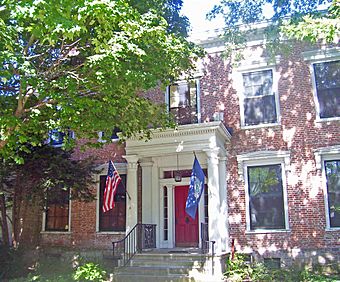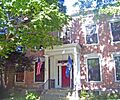First Columbia County Courthouse facts for kids
The First Columbia County Courthouse is an old brick building in Claverack, New York. It was built in 1786 in the Federal style, which was a popular building style back then. This building was the main courthouse for Columbia County for about 20 years. Famous people like Martin Van Buren, who later became president, argued cases here. Even Alexander Hamilton might have worked on cases in this building. An important court case about free speech, called the Harry Croswell libel case, also started here. After it stopped being a courthouse, the building was used for meetings and later turned into apartments. In 1998, it was added to the National Register of Historic Places, which means it's an important historical site.
Quick facts for kids |
|
|
First Columbia County Courthouse
|
|

West elevation, 2008
|
|
| Location | Claverack, NY |
|---|---|
| Nearest city | Hudson |
| Area | 1.5 acres (6,100 m2) |
| Built | 1786 |
| Architectural style | Federal |
| MPS | The Architectural and Historic Resources of Claverack |
| NRHP reference No. | 97001623 |
| Added to NRHP | 1998 |
Contents
The Courthouse Building
The old courthouse is on the north side of Route 23B in Claverack. It's across the street from another historic house, the Stephen Hogeboom House. The area around it has many old houses from the 1700s and 1800s. The courthouse sits on a plot of land about 1.5 acres in size. There's also a modern garage and a small garden structure (a gazebo) on the property. These newer additions are not part of the building's original historic value.
Outside the Courthouse
The courthouse is a two-story building made of brick. It has five windows on the front and four on the sides. It sits on a stone base and has a pointed roof made of metal. Along the roofline, there's a wide decorative band called a frieze with small blocks (modillions) and a fancy edge (cornice).
On the back (north side), there's a two-story brick section, which has another two-story wooden section attached to it. A smaller, one-story addition with a flat roof is on the west side.
The front of the building faces south and has a main entrance with a small porch. This porch has a flat roof and is held up by two columns with vertical grooves (fluted). The main door has narrow windows on the sides and a window above it (a transom). The door itself has four panels and is framed by decorative moldings.
On the east side, there are three windows on the first floor and two on the second. The pointed part of the roof (gable) on this side has a large, rounded window that looks like a fan. The other sides of the building are mostly covered by the attached sections.
Inside the Courthouse
When you go inside, there's a narrow hallway in the middle. On each side of the hall, there are two rooms of the same size. The hallway used to go all the way through the building, but it's shorter now. The brick section in the back has been changed a lot to become an apartment. You can still see where an old fireplace used to be in the brick wall, even though it's covered now. The building doesn't have a basement. The wooden addition has also been updated.
Some extra support has been added to the lower parts of the building. A wall that helps hold up the building runs along the east side, next to the hallway. Two old wooden posts with cut edges have been placed under the southwest room to make it stronger.
History of the Courthouse
The building was used as a courthouse for its first 20 years. During that time, many important lawyers worked there, and a very significant court case began within its walls. After its time as a courthouse ended, it became a meeting place and then a home. Later, it was renovated to become apartments.
1786–1806: The Courthouse Years
Columbia County was created in 1786, and Claverack was chosen as its main town for government. That same year, a local resident named Gabriel Esselstyne sold the land for the courthouse to the county for £20 (about $2,500 in today's money). A builder named William Ludlow started construction in July. Some stories say it took two years to finish and cost £3,600 (about $450,000 today). The courthouse was built where two important roads met: an old Native American trail (now Route 23 and 23B) and the original Albany Post Road.
The court building had a small jail in the back. There were also places nearby for public punishments, like a pillory (a device that held people's heads and hands) and a "hanging tree" for more serious crimes. The pillory is gone now, and no one knows exactly where the hanging tree was.
Even while the building was being built, the first court sessions were held in 1787, with Judge Peter Van Ness in charge. Many top lawyers in New York at the time became part of the county's legal community. These included William Peter Van Ness, Ambrose Spencer, Thomas P. Grosvenor, and Peter van Schaack. These men later became important judges and public officials. Martin Van Buren, who lived nearby, started his law career arguing cases in this courthouse before he became president of the United States. It's also very likely that Alexander Hamilton, a Founding Father, appeared in the building. He was a lawyer for his wife's family, who had ongoing legal disputes about their land in what is now Hillsdale.
In the early 1800s, a very important court case about free speech in America started in Claverack. Harry Croswell, a young journalist from nearby Hudson, supported the Federalist Party (an early political party). He wrote articles criticizing President Thomas Jefferson and his supporters in his newspaper, The Wasp. Because of this, Ambrose Spencer, who was the state's top lawyer (Attorney General) at the time, accused Croswell of breaking the Alien and Sedition Acts in 1803.
Spencer personally handled the case, and Croswell was found guilty. Croswell appealed the decision to New York's highest court. In his defense, Alexander Hamilton gave a six-hour speech, arguing that if something was true, it couldn't be considered a harmful lie (libel). The judges couldn't agree on a decision, so Croswell was never sentenced or tried again. The next year, in 1805, the state legislature made Hamilton's argument into a state law. This was a big step for freedom of the press.
That same year, the main county government offices were moved to Hudson. Hudson was growing quickly because it was an important center for whaling. Court cases continued to be heard in Claverack for another year while the new courthouse was being built in Hudson. Many lawyers and judges still lived in Claverack because it was a short and easy trip to Hudson.
1807–Present: New Uses
Even after the courts left, the courthouse remained an important building in the community. Its high ceilings made it a great place for public meetings, and it was also used for teaching and dances. In 1843, the county sold the building. The new owner, Peter Hoffman, was a merchant from Brooklyn who had moved upstate. He made some changes to the building, adding elements of the Greek Revival style. The most noticeable change was the front porch, which looked similar to the porch on the Hogeboom house across the street.
Over the next century, several other owners, who also used to live in New York City, moved into the house. At some point, a wooden kitchen section was added to the back. Some owners made other changes, giving the house a mix of city and country styles. It also has some of the most detailed decorations of any Federal-era house in the county.
After World War II, in the late 1940s, a new owner decided to turn the building into apartments. This led to many changes inside, especially in the back section. The garage was also added around this time. No major changes have been made to the building since then.
Images for kids




